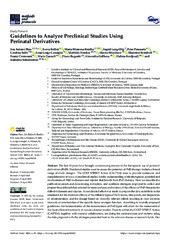| dc.creator | Pires, Ana Salomé | |
| dc.creator | Bollini, Sveva | |
| dc.creator | Botelho, Maria Filomena | |
| dc.creator | Lang-Olip, Ingrid | |
| dc.creator | Ponsaerts, Peter | |
| dc.creator | Balbi, Carolina | |
| dc.creator | Lange-Consiglio, Anna | |
| dc.creator | Fénelon, Mathilde | |
| dc.creator | Mojsilović, Slavko | |
| dc.creator | Berishvili, Ekaterine | |
| dc.creator | Cremonesi, Fausto | |
| dc.creator | Gazouli, Maria | |
| dc.creator | Bugarski, Diana | |
| dc.creator | Gellhaus, Alexandra | |
| dc.creator | Kerdjoudj, Halima | |
| dc.creator | Schoeberlein, Andreina | |
| dc.date.accessioned | 2023-07-11T10:02:26Z | |
| dc.date.available | 2023-07-11T10:02:26Z | |
| dc.date.issued | 2023 | |
| dc.identifier.issn | 2409-9279 | |
| dc.identifier.uri | http://rimi.imi.bg.ac.rs/handle/123456789/1297 | |
| dc.description.abstract | The last 18 years have brought an increasing interest in the therapeutic use of perinatal derivatives (PnD). Preclinical studies used to assess the potential of PnD therapy include a broad range of study designs. The COST SPRINT Action (CA17116) aims to provide systematic and comprehensive reviews of preclinical studies for the understanding of the therapeutic potential and mechanisms of PnD in diseases and injuries that benefit from PnD therapy. Here we describe the publication search and data mining, extraction, and synthesis strategies employed to collect and prepare the published data selected for meta-analyses and reviews of the efficacy of PnD therapies for different diseases and injuries. A coordinated effort was made to prepare the data suitable to make statements for the treatment efficacy of the different types of PnD, routes, time points, and frequencies of administration, and the dosage based on clinically relevant effects resulting in clear increase, recovery or amelioration of the specific tissue or organ function. According to recently proposed guidelines, the harmonization of the nomenclature of PnD types will allow for the assessment of the most efficient treatments in various disease models. Experts within the COST SPRINT Action (CA17116), together with external collaborators, are doing the meta-analyses and reviews using the data prepared with the strategies presented here in the relevant disease or research fields. Our final aim is to provide standards to assess the safety and clinical benefit of PnD and to minimize redundancy in the use of animal models following the 3R principles for animal experimentation. | |
| dc.publisher | Multidisciplinary Digital Publishing Institute (MDPI) | |
| dc.relation | University of Genova, Curiosity Driven Grant “TriggeringCARDIOmyocyte renewal by harnessing the STem cell pARacrine potential (CARDIO-STAR)” | |
| dc.relation | Foundation for Science and Technology (Portugal) through the Strategic ProjectUIDB/04539/2020 and UIDP/04539/2020 (CIBB) | |
| dc.relation | University of Geneva, Horizon 2020 Framework Program (VANGUARD 874700) | |
| dc.rights | openAccess | |
| dc.rights.uri | https://creativecommons.org/licenses/by/4.0/ | |
| dc.source | Methods and Protocols | |
| dc.subject | perinatal derivatives | |
| dc.subject | preclinical studies | |
| dc.subject | animal models | |
| dc.subject | database search | |
| dc.subject | consensus | |
| dc.subject | protocol | |
| dc.title | Guidelines to Analyze Preclinical Studies Using Perinatal Derivatives | |
| dc.type | article | |
| dc.rights.license | BY | |
| dc.citation.issue | 3 | |
| dc.citation.spage | 45 | |
| dc.citation.volume | 6 | |
| dc.identifier.doi | 10.3390/mps6030045 | |
| dc.identifier.fulltext | http://rimi.imi.bg.ac.rs/bitstream/id/2950/Guidelines_to_Analyze_Preclinical_Studies_Using_Perinatal_Derivatives_2023.pdf | |
| dc.type.version | publishedVersion | |

